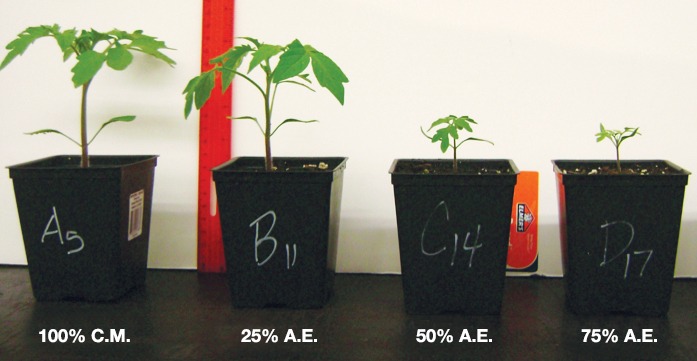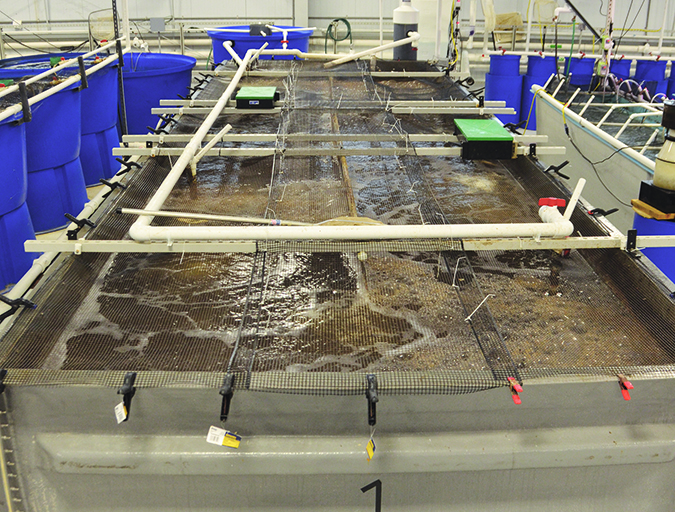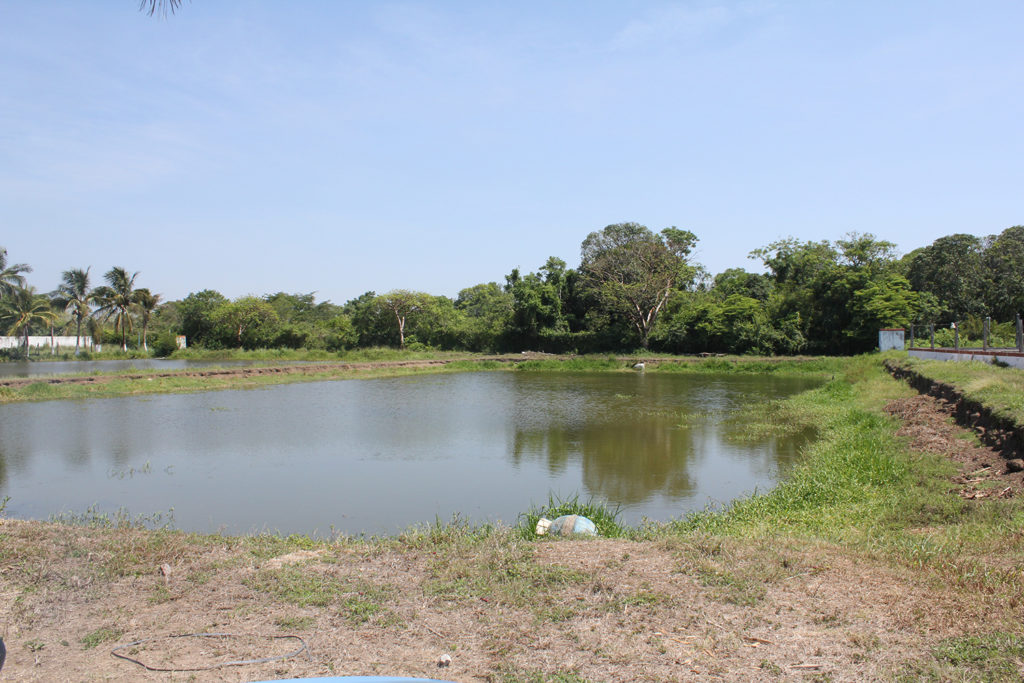Through its Responsible Aquaculture Program, GAA has recommended a range of water quality standards for shrimp farm effluents. Part of a series, this article addresses Total Suspended Solids (TSS).

Solids in water are either in true solution or suspended. Suspended solids remain in suspension because they are so small and light. Turbulence resulting from wind and wave action in impounded water, or the movement of flowing water helps maintain particles in suspension. When turbulence decreases, coarse solids quickly settle from water. Very small particles, however, may have colloidal properties, and can remain in suspension for long periods even in completely still water.
The distinction between suspended and dissolved solids is somewhat arbitrary. For practical purposes, filtration of water through a glass fiber filter with openings of 2 μ is the conventional way of separating dissolved and suspended solids. Dissolved solids pass through the filter, while suspended solids remain on the filter.
Inorganic and organic particles
Inorganic suspended solids in shrimp pond waters consist primarily of soil particles. Sand and silt particles settle rapidly, and smaller clay particles generally comprise most of the suspended inorganic particles in pond water. However, when ponds are drained, the final 20 to 25 percent of the drained water contains mixed particles resuspended from pond bottoms by seining activities and maintained in suspension by the turbulence of outflowing water.
Organic particles in pond waters include living bacteria, phytoplankton, zooplankton, and the dead remains of these organisms. Organic particles also result from uneaten feed, feces of culture organisms, sediment resuspension and other sources.
Limiting concentrations of solids
There are several reasons to limit concentrations of suspended solids in effluents. Suspended solids in effluents can create a plume of discolored water in receiving water bodies. If the plume covers a large area, a decrease in light penetration and phytoplankton productivity in the receiving water can occur.
Restriction of light is also harmful to sea grasses, coral reefs, and other sensitive underwater habitats. Most manuals on water quality criteria suggest the allowable change in total suspended solids or turbidity should not be greater than 10 percent of the seasonal mean concentration in order to prevent adverse impacts on aquatic organisms.
Suspended solids can settle and accumulate in areas around effluent outfalls. Shallow water conditions resulting from sedimentation may interfere with local navigation, fishing, and other beneficial uses. Where effluent is directed into mangrove stands, excessive sedimentation can stress or kill trees. Rapid sediment accumulation also can bury benthic organisms and smother them.
https://www.aquaculturealliance.org/advocate/water-quality-standards-total-ammonia-nitrogen/
Oxygen demand
Living plankton and bacteria in aquaculture pond effluents normally do not settle rapidly. Their density is only slightly greater than water, and some planktonic organisms have special mechanisms such as gas vacuoles, projecting appendages, or even mobility to help them remain in the upper, illuminated water layer. Where plankton and bacteria increase in the water column around outfalls, dissolved oxygen concentration decreases, especially at night.
Dead organic particles do not settle as rapidly as mineral soil particles because they are less dense. Such particles in the water column increase oxygen demand, and if dead organic matter accumulates in sediment, the sediment oxygen demand will also increase. High sediment oxygen demands result in anaerobic conditions that cause undesirable changes in aquatic communities. Toxic metabolites can enter the water from anaerobic sediment and harm sensitive aquatic animals.
Measuring solids
The most reliable method of measuring total suspended solids is to remove the suspended solids by filtration and measure their concentration by gravimetry. In the analysis, a known volume of water is passed through a filter, and the dry weight of the residue retained on the filter is measured.
For example, suppose a 100-ml water sample is passed through a glass fiber filter weighing 2 grams. The filter and residue are then dried at 102 degrees-C, and after cooling weigh 2.01 grams. The weight of the residue is therefore 0.01 grams (10 mg).
The residue was from 100 ml of water, so the number of mg in 1 liter of water would be 10 times greater than for the sample. Thus, the total suspended solids concentration is 100 milligrams per liter (or 100 ppm, because 1 milligrams per liter is equivalent to 1 ppm). It is important to remember that particles will settle from water held in sample bottles. Thus, bottles containing samples for total suspended solids analysis should be thoroughly agitated before water is poured and measured.
The equipment needed for measuring total suspended solids includes filters, 100-ml graduated cylinders, filter holders, a vacuum source, drying oven, semi-micro analytical balance, and desiccator. This equipment is expensive, and a well-trained analyst is needed to make the analyses. Thus, in many cases, it may be more accurate and less expensive to have analyses made by a private laboratory.
There are instruments that provide direct estimates of total suspended solids concentrations based on turbidity. However, measurements made by this procedure are not as reliable as those made by filtration and gravimetry, and usually are not acceptable for demonstrating compliance with effluent standards.
Recommended concentration limits
GAA recommends an initial concentration limit for total suspended solids in shrimp farm effluents of 100milligrams per liter, with a required target limit of 50 milligrams per liter to be attained as soon as feasible. Effluents from aquaculture ponds often exceed 100 milligrams per liter, so compliance with the total suspended solids limit will require effort on the part of farm managers.
The concentrations of total suspended solids in shrimp pond water can be minimized by removal of suspended solids from incoming water by sedimentation, measures to prevent erosion of embankments and bottoms of ponds, prevention of excessive plankton blooms, and minimizing the suspension of sediment during draining to harvest ponds.
Settling basins and sedimentation
Effluents can be passed through settling basins to lower suspended solids concentrations before final discharge. Settling basins are especially efficient for treating shrimp farm effluents, because the high concentrations of positively charged ions (cations) in seawater and brackishwater tend to neutralize the negative charges on suspended clay particles. When these negative charges are neutralized, the clay particles flocculate and the particles of floc become heavy enough to settle from the water.
Sedimentation aids such as aluminum sulfate, lime and selected organic colloids often used in wastewater treatment are not needed in shrimp farm settling basins. Plankton cannot be removed efficiently by sedimentation.
Settling basins are efficient and cost-effective in reducing solids, although they fill in with sediment over time, and this sediment must be removed. A plan for environmentally responsible disposal of solids from settling basins should be prepared and implemented.
Through its Responsible Aquaculture Program, the Global Aquaculture Alliance has recommended water quality standards for shrimp farm effluents that include values for pH, total suspended solids, total phosphorus, total ammonia nitrogen, five-day biochemical oxygen demand, and dissolved oxygen. Part of a series, this article discusses total suspended solids.
(Editor’s Note: This article was originally published in the April 2001 print edition of the Global Aquaculture Advocate.)
Now that you've reached the end of the article ...
… please consider supporting GSA’s mission to advance responsible seafood practices through education, advocacy and third-party assurances. The Advocate aims to document the evolution of responsible seafood practices and share the expansive knowledge of our vast network of contributors.
By becoming a Global Seafood Alliance member, you’re ensuring that all of the pre-competitive work we do through member benefits, resources and events can continue. Individual membership costs just $50 a year.
Not a GSA member? Join us.
Author
-

Claude E. Boyd, Ph.D.
Professor, Department of Fisheries and Allied Aquacultures
International Center for Aquaculture and Aquatic Environments
Auburn University
Auburn, AL 36849 USA
Related Posts

Responsibility
Aquaculture effluent partially replaces growing mix for plant production
Aquaculture effluent can be an effective fertilizer in land-based plant production. Research with tilapia utilized dewatered aquaculture effluent (A.E.) as a partial substrate replacement for tomato plant seedlings. Seedling growth decreased when effluent replaced a commercial growing mix at 25 percent or more.

Responsibility
Effluent effects from aquaculture ponds
In general, lower-intensity pond and cage farming tends to discharge higher overall pollution loads in farm effluents than closed aquaculture systems.

Intelligence
Indoor-raised shrimp find potential market in Kentucky test
By raising shrimp in a closed building, producers can increase biosecurity, produce shrimp more consistently, grow shrimp year-round and locate production centers near markets. Chefs and consumers were very accepting of whole fresh shrimp, offered at a farmers market, that was farmed indoors in Kentucky.

Responsibility
Treatment of shrimp hatchery effluents
Shrimp hatcheries are highly dependent on continuous availability of clean water and proper treatment of effluents using sedimentation and biofiltration.

